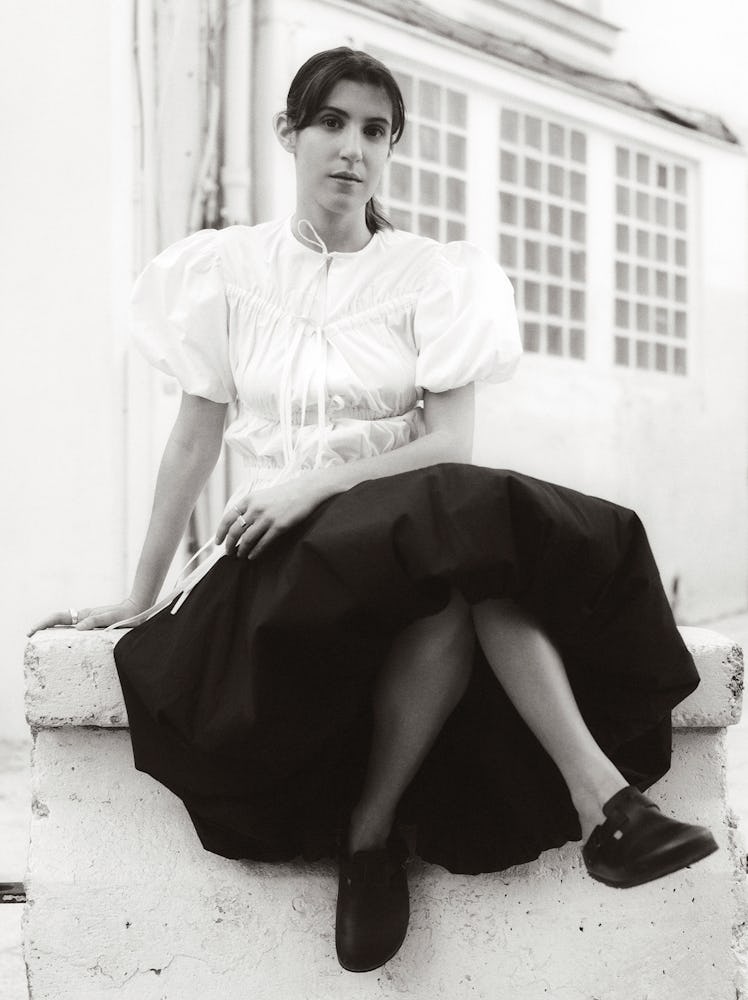For Renaissance Renaissance Designer Cynthia Merhej, Less Is More
With her sophisticated yet down-to-earth approach, the Lebanese talent aims to create a brand that will stand the test of time.

Just before the photographer’s crew started trickling into Cynthia Merhej’s apartment in Paris to prepare for the W shoot you see here, the designer was busy multitasking. One of the models, Nyakong Chan, who had arrived early, hadn’t yet had breakfast. Merhej stopped arranging the fruit and cookies she was plating for the team to make her a fried egg. A rack of the smart, romantic clothes she designs for her label, Renaissance Renaissance, was in the bedroom waiting to be organized: leg-of-mutton–sleeve blazers; a muslin-trimmed fur stole cut from a vintage mink coat; a pinstriped, double-breasted, draped capelet; a blouse made out of the shirred tulle that has become one of the indie label’s signatures. But this took priority. “You want a little salad?” she asked Chan. “Some cucumber and tomato? No? Okay, I’ll put the cucumber in the water.”
We had been talking about everything it took to get Merhej, 33, to Paris and this minimalist flat, which she shares with her husband, Jonathan Blezard, a Belgian ceramics illustrator. The couple had come from Beirut, where Merhej grew up; her father is an engineer, and her mother, in whose atelier Merhej spent much of her childhood, is a fashion designer. “When I was a kid, whenever I was sad or upset, I would just close my eyes and dream of a collection,” recalled Merhej. “Even dressing up Barbies would soothe and relax me.”
Designer Cynthia Merhej (second from left) with a cast of models and friends, including (from left) designer Linda Abdalla, model Clara Fossar, designers Linda Schraner and Tracy Zeidan, artist Christine Safa, and model Nyakong Chan. All wear Renaissance Renaissance. Stylist’s own tights and footwear.
Nonetheless, Merhej opted not to study fashion. Attending Central Saint Martins, in London, for visual communication, she witnessed through friends how stressful the industry was. But she came around to it soon enough, first by making her own clothes with her mom and then by debuting Renaissance Renaissance back in Beirut, while she worked on the side as a DJ and an illustrator to pay the bills. Inspired by the Japanese designers of the 1980s, traditional Arab clothes from the 17th and 18th centuries, and the golden age of Paris couture, the label specializes in strong tailored silhouettes with a healthy dose of whimsy.
Starting in 2019, just as Renaissance Renaissance was gaining traction, Lebanon underwent a series of traumatic shocks. The first was a devastating financial collapse, which saw the country’s currency lose 90 percent of its value; then came a failed revolution; a few months later, Covid hit; and shortly thereafter, almost 3,000 tons of ammonium nitrate exploded in the Port of Beirut—the most powerful non-nuclear blast in human history. “It was a chain of events unimaginable for most people,” said Merhej.
Fossar and Chan.
She would travel to Paris when she could to show her work. Net-a-Porter ended up carrying her collections, giving her some desperately needed financial support. Still, it took a herculean effort to get things done in Beirut. “We were sewing by hand and cutting in the dark,” recalled Merhej. “The electricity would come on for a few hours, and we’d do what we could in that time.” Ultimately, she realized she had no choice but to leave her country. There was a brief partnership with a fashion incubator with production in Italy that allowed her to focus on design, and her clothes started hitting the mark with stockists like SSENSE, Beams, and Shop Amomento.
“Cynthia’s work feels closer to bespoke dressmaking or what you see in old movies than to anything trendy—it’s very feminine and elegant, and not overdone,” said Junsung Bae, Shop Amomento’s buyer, adding that Renaissance Renaissance appeals to women of all ages. Stylists like Louise Ford, who worked on this story, have been another crucial source of support. “The clothes fit every single brief I get because they are timeless,” she said. “You can do a modern girl or something super artsy.”
Chan.
Last year, Merhej returned to Beirut to produce a collection that included one-off, demi-couture pieces made from upcycled vintage and deadstock fabric. Creating a sustainable, hands-on company has always been a core concern for her. “This is how I grew up my whole life,” she said, huddling in the office she shares with Blezard while the W shoot was being set in motion just one room over. “My mother taught me, it’s not just about clothes looking beautiful; they have to be made with really high-quality materials and finishing, so that they last. What’s the point of making 100 organic T-shirts if I’m going to throw 99 of them in a landfill? I’ll make five T-shirts and sell them to people who are actually going to wear them. I’m not going to make much money that way, but that’s fine.”
There was a knock at the door; lunch was on the way. It looked to me like nobody had even made a dent in the fruit and cookie tray, but skimping on the midday meal was out of the question. “This is very Lebanese,” said Merhej. “We’re all about feeding people all the time.”
Hair by Andrea Idini for GHD at Walter Schupfer Agency; makeup by Akari Sugino for Glossier at St. Vincent Management; casting by DM Casting; models: Nyakong Chan at Select Models, Clara Fossar at Premium Models, Linda Abdalla, Christine Safa, Linda Schraner, Tracy Zeidan; photo assistants: Matheus Agudelo, Viktor Podcacha; fashion assistant: Ruairi Horan; hair assistants: Tsuyoshi Tamai, Fabian Renna; makeup assistants: Ophelie Mirambeau, Azusa Kumakura.
This article was originally published on